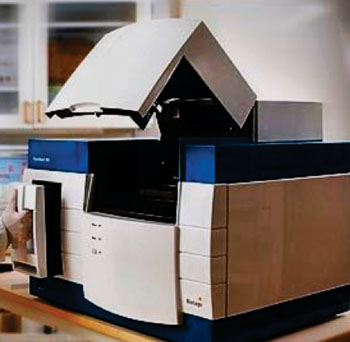DNA-Based Test Determines Degree Of Liver Fibrosis
By LabMedica International staff writers
Posted on 28 Apr 2016
Non-alcoholic fatty liver disease (NAFLD) accounts for the majority of liver disease burden in the Western world. Liver biopsy remains the gold standard test to accurately stage fibrosis in patients with NAFLD, but it is invasive and carries risks.Posted on 28 Apr 2016
A DNA-based test has been developed that determines the degree of fibrosis in the liver which could be a replacement for a liver biopsy and this new type of genetic blood test diagnoses scarring in the liver even before an individual may feel ill.

Image: The Pyromark Q96 MD pyrosequencing instrument (Photo courtesy of Qiagen).
Scientists at Newcastle University (Newcastle upon Tyne, UK) recruited 26 patients with biopsy-proven NAFLD and age-matched controls from the liver and gastroenterology clinics. Plasma cell-free circulating DNA methylation of peroxisome proliferator-activated receptor gamma (PPARγ) was quantitatively assessed by pyrosequencing. Liver DNA methylation was quantitatively assessed by pyrosequencing NAFLD explant tissue, subjected to laser capture microdissection (LCM). Patients with alcoholic liver disease (ALD) were also subjected to plasma DNA and LCM pyrosequencing.
DNA was extracted from 200 μL of plasma and DNA was also extracted from laser capture microdissected tissue (PALM MicroBeam, Zeiss, Jena, Germany) using the QIAamp DNA micro kit (Qiagen, Venlo, Netherlands). Methylation of specific cytosines within CpG dinucleotides was quantified by pyrosequencing using a Qiagen Pyromark Q96 MD instrument. Percutaneous liver biopsies were performed for histological assessment.
Quantitative plasma DNA methylation of PPARγ stratified patients into mild (Kleiner 1–2) and severe (Kleiner 3–4) fibrosis (CpG1: 63% versus 86%; CpG2: 51% versus 65%). Hypermethylation at the PPARγ promoter of plasma DNA correlated with changes in hepatocellular rather than myofibroblast DNA methylation. Similar results were demonstrated in patients with ALD cirrhosis. Jelena Mann, PhD, the senior author of the study said, “This is the first time that a DNA methylation 'signature' from the blood has been shown to match the severity of a liver disease. It opens up the possibility of an improved blood test for liver fibrosis in the future.”
The authors concluded that differential DNA methylation at the PPARγ promoter can be detected within the pool of cell-free DNA of human plasma. With further validation, plasma DNA methylation of PPARγ could potentially be used to non-invasively stratify liver fibrosis severity in patients with NAFLD. Plasma DNA methylation signatures reflect the molecular pathology associated with fibrotic liver disease. The study was published on March 21, 2016 in the journal Gut.
Related Links:
Newcastle University
Zeiss
Qiagen













